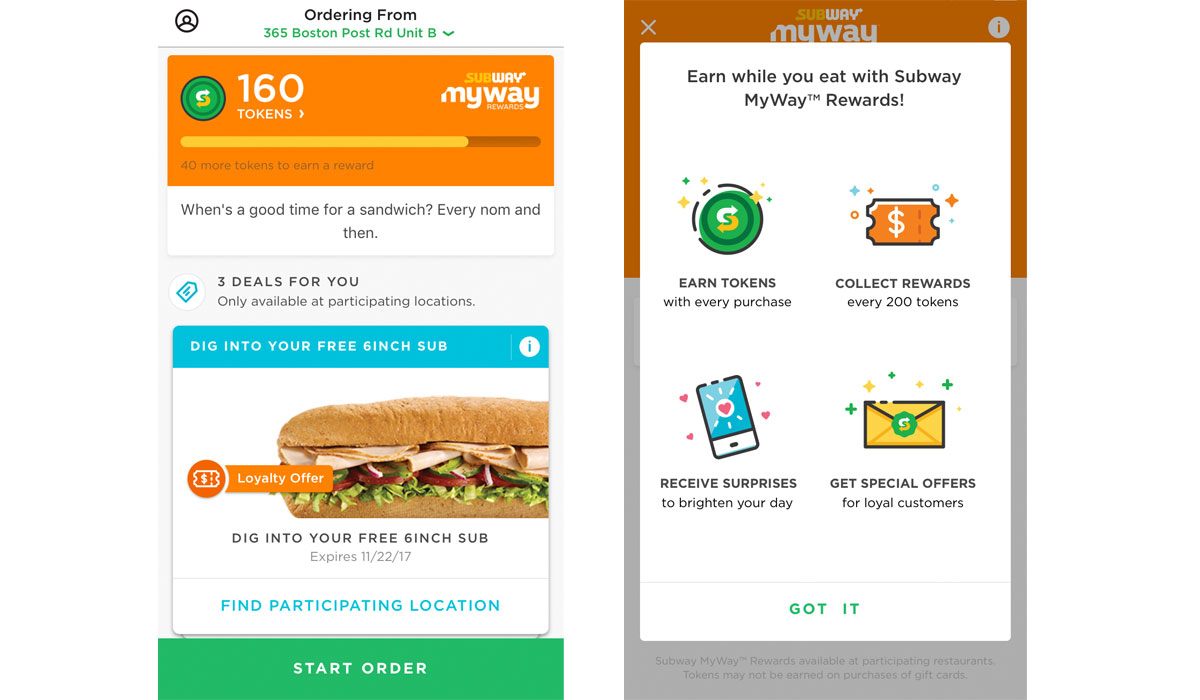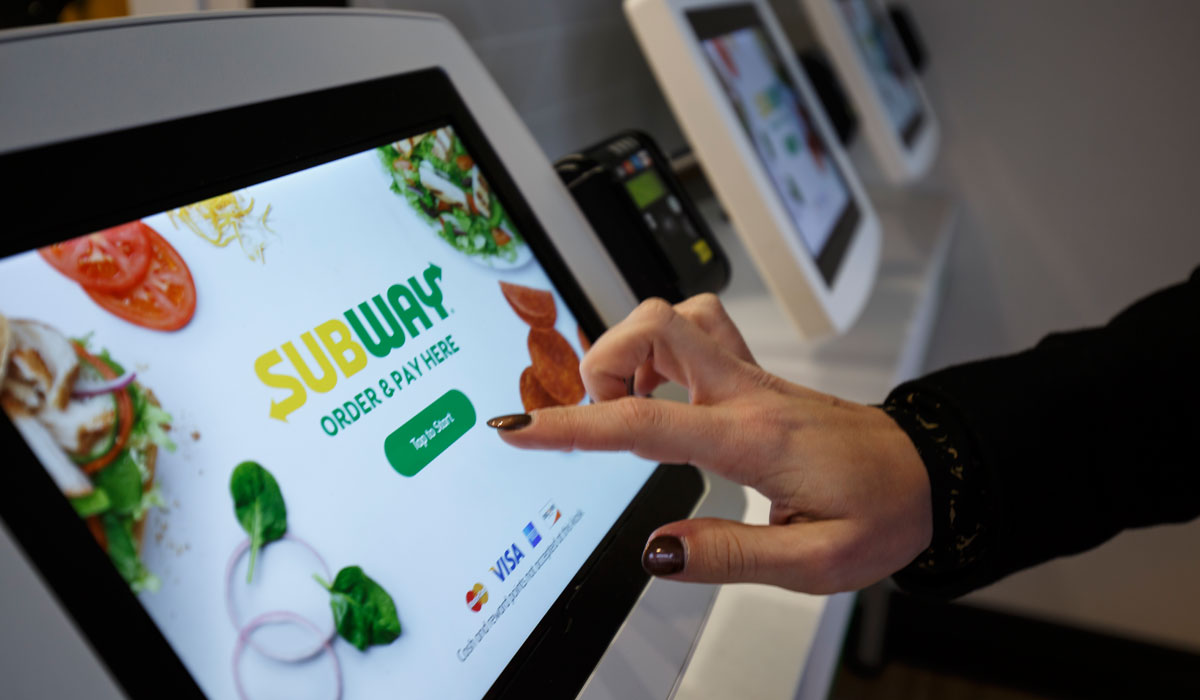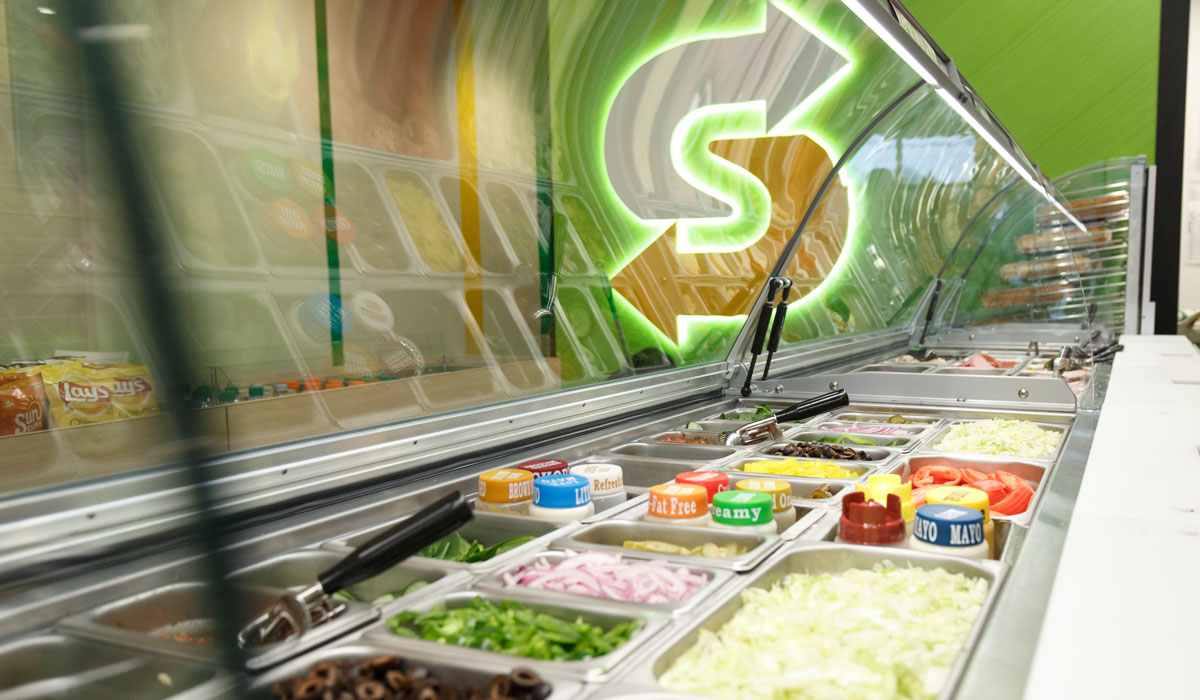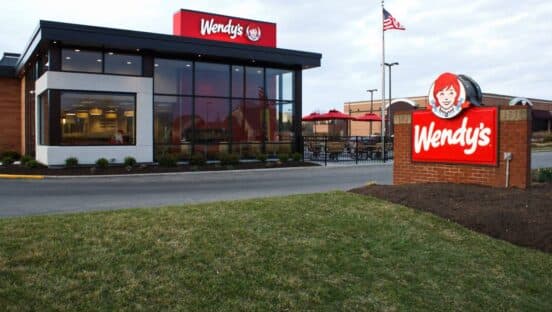When Subway’s “Fresh Forward” revamp hit the marketplace in 2017, the design elements—everything from a vegetable display case to the hard-to-miss “S” Choice Mark logo—crowded headlines. And rightfully so. A year later, the world’s largest restaurant chain saw a gross profit lift of 11 percent and increased traffic around 8 percent in its remodeled units. At the same time, however, chief digital officer Carissa Ganelli and her team were preparing to relaunch Subway’s app as part of the company’s overhaul. Subway, which ended 2017 with 25,908 U.S. locations, has since witnessed 25 percent month-over-month user growth in its app following the May redesign. Year-over-year, Subway’s growth of users is up a whopping 100 percent, Ganelli says.
This is a major component of Subway’s efforts to reenergize its system. The chain trimmed its U.S. unit count by 866 restaurants from 2016–2017 and 359 from 2015–17 after adding 4,445 stores the previous six years combined. This retraction is part of a relocation and revamping strategy that searches for prime locations and banks on updated designs. In September, Subway said the new look was in 465 locations. In addition to the lift seen at refreshed stores, Subway noted that in Fresh Forward designs at relocated restaurants versus remodels, it saw an even steeper hike in sales and traffic—about 18 percent and 15 percent, respectively.
READ MORE: Reflecting on a year of ‘Fresh Forward.’
The digital element is critical to courting lapsed users who might have fallen off when the brand stagnated a bit. It’s also key to keeping those core, loyal guests engaged, Ganelli says, and locking in fresh users who are being introduced to Subway for the first time, especially younger diners who aren’t typically brand loyal by nature. And winning the app war is no easy task in today’s mobile universe. According to a Statista report last year, there were more than 2 million apps on the Apple App store. Research from App Annie showed 60 percent growth in the number of apps downloaded globally. The amount of time users spent inside of apps lifted 30 percent. Another data point: Quettra reported that within 90 days of download, the average app loses 95 percent of its active user base.
Those kinds of behaviors don’t necessarily apply to quick-serves, though. Not those that get their app experience right at least. Ganelli puts it like this: Often times you’ll see a promotion that promises something in response for downloading an app. Say, sign up and get $10 off your next T Mobile bill. But once the deal pulses, it disintegrates. Is there any reason to return and use the app on a daily basis?

“We’ve deliberately not done that kind of promotion,” Ganelli says. “Because getting a lot of app downloads doesn’t help us drive business into the restaurants. What we want to do is provide a tool for people who already love Subway to make it easier for them to buy. Make it easier for them to order. So if that’s your approach, then you’re only going to attract your already most loyal customers. App users in general for every company are users. Not downloads. Users. They are already your most frequent loyal customers out of the gate.”
Food isn’t like other commodities, either. It’s a high-frequency item because, naturally, we all have to eat. Perhaps three times a day. And based on where you live or work and how far you’re willing to travel, there are a limited assortment of choices. It makes something like an app a valuable tool for not just loyalty, but to court and foster the ultimate target for today’s limited-service customers, especially if we’re talking about triggering frequency and specific daypart business—convenience.
And this is really where Subway put its hooks into development. Beyond some low-level advertising spent in the app store itself, Subway hasn’t really marketed the app. It did some POP displays for about a month in January. That was it.
“We really have not advertised it all intentionally because we needed to collect a baseline of data before we start doing some paid media advertising on other activities. So it’s really just kind of building on itself,” Ganelli says.
Convenience reigns
Subway likes to tout the statistic there are 4.9 billion combinations to make a sandwich. Ganelli saw that as an opportunity for the digital team. What Subway did that’s different than most chains is they worked the customization process backward, in a sense. Customers in the app start with a prebuilt sandwich as opposed to a blank slate—a process that doesn’t mimic the in-store buying experience. In this case, Subway curates a preconfigured option and users subtract, replace, and add on as they go. Ganelli says that behavior is typical of mobile customers.
[float_image image=”https://www.qsrmagazine.com/wp-content/uploads/2016/08/subway.jpg” width=”50″ link=”” caption=”Carissa Ganelli says Subway “assembled a team of subject matter experts from best-in-class companies, and this is pretty much what we do every day.”” alt=”” align=”left” /]
Is there something also to be said of feeling better about an order where you remove instead of add ingredients, from a health-forward perspective? That’s perhaps best left for a leather-chair discussion later on.
Ganelli says this prebuild process generates stellar reviews. They enjoy swiping ingredients on and off. She tells an anecdote of when she visited a high school graduation party and handed the phone to some recent grads. “And I didn’t see my phone again until the end of the night,” she says, with a laugh. “They were just having a ball.”
It’s also a time saver. “Those are the default ingredients on the sandwich and then you can say, you know what, I love all of it, but I really don’t want onion because I’ve got a hot date later. But instead I would rather have bacon. So then you’re not building it from scratch and it’s taking you 10 minutes,” Ganelli says.
The clear next step is the ability to save these creations. That’s a crucial element, Ganelli says, for somebody like her, who has a complicated order that’s simply a pain to repeat every time you walk in the store. Her favorite is a turkey footlong on white with lettuce, tomato, spinach, pickles, extra, extra, extra olives, salt and pepper, Subway vinaigrette, not toasted, no cheese. Try telling that to a friend going to pick up dinner.
In Subway’s app you can name the sandwich and save it as whatever you want, like “Friday night dinner,” and so on. Add a stored payment method, and users can now access one-click rebuying.
The convenience element is everything, Ganelli says. Generally speaking, there’s often a tradeoff with getting food fast. Either you’re sacrificing quality or you’re lowering the bar for accuracy, or maybe you’re just a bit more forgiving on all accounts. It’s akin to pulling through the drive thru and realizing they left the cheese on your burger when you asked to get it removed. Will the average harried guest turn back around or just peel the cheese off?
Subway’s app prints out the ingredient list and the order shows up as a ticket in the restaurant, which allows the employee to make it exactly to spec.
“It’s not up to interpretation to the person in the restaurant making it,” Ganelli says.

Never stop evolving
Along this yearly growth, Subway has released a new version of the mobile app every month. Some of these changes have been visible to the customer, some haven’t. For instance, Subway, in its October update, launched a save-to calendar. Here the user can see a deal, like $1 off a 6-inch sub from November 15–20, pushed to their app. The app now will ask if you want to save it to the calendar. Then a calendar reminder will pop up once the deal is valid.
Some of the back-end changes have included making Subway’s app ADA compliant—ensuring screens can be read by screen readers for visually impaired users.
Ganelli’s team is made up of tech-junkies who came from outside Subway. Ganelli herself is the founder and former CEO of LightningBuy, a mobile commerce platform startup. One team member has 300 patents to his name. Another launched the keyless entry app for Starwood. “We really assembled a team of subject matter experts from best-in-class companies, and this is pretty much what we do every day,” Ganelli says.
“If we didn’t roll out with improvements every month, we would probably all leave because this is in our DNA,” she adds. “We just constantly are trying to push the envelope. Meet consumer’s expectations. Make it as easy as possible for them to get and buy our delicious sandwiches.”
“It’s not possible for us to sit around doing nothing. In our free time we follow UI/UX designers. OK, that’s crazy. We need hobbies.”
Getting Rewards right
This past March, Subway launched what it called the largest loyalty program in quick-service history. It was built on the premise of a more customized experience wherein users can earn and redeem tokens in a variety of ways. The program is integrated into the new version of the app. Subway, like many brands, once featured a punch-card program called Sub Club.
According to consumer research firm YouGov BrandIndex, when the company announced the Subway MyWay Rewards February 22, 37 percent of adults aged 18 and older said they would consider purchasing Subway as their next fast-food meal. In the ensuing weeks that number grew to 40 percent with quality and satisfaction scores also rising.
“The sharper consideration increase among the general population suggests that the refresh might convince people who have left Subway to give it another try. That could be good news for the brand if it can delight those consumers and turn them into regular customers,” Ted Marzilli, CEO of YouGov, said in March.

It was up to Ganelli and her team to make sure those new and returning users stuck around. Achieving that came back to some previous goals, but with an uber-personal touch.
The rewards program has a few main elements:
A cashback reward. But instead of just giving guests money for using money, Ganelli says Subway wanted to make sure this process was personalized, too. Some other loyalty programs might box in those rewards—here’s $2 but you need to buy a pastry. Or spend $20 and get a free cookie. Subway doesn’t care where the money is spent and it lets digital users stack the rewards and use them all in one transaction, if that’s what they want.
“So in one transaction, you could have redeemed four $2 certificates, gotten a $1 off deal that was going on for non-loyalty members, and gotten a free birthday cookie,” Ganelli says.
They’re also not automatically applied. This is helpful in cases where someone might be using the app to order food for multiple people, like their office, and don’t want to spend their rewards. Those deals stay on the dashboard and can be applied or hoarded to the customer’s schedule.
Driverless cars and a limitless future
So what’s next in this rapidly changing digital conversation? Ganelli leans toward virtual reality, or augmented reality, over the infusion of artificial intelligence into foodservice.
“I don’t need machine learning, I need data and rules,” she says. “I need to observe customer data and I need to create some rules. I’m not trying to use machine learning, where the algorithm modifies itself based on more data that comes in. We’re not doing brain surgery here.”
What Ganelli sees is a virtual projection of a restaurant where guests can order through an augmented reality-ordering interface. Picture sitting at home and projecting a Subway in your living room. Instead of walking into a physical location, you order from a virtual assistant or projected version of a sandwich artist and make your choices. Sounds a bit otherworldly but it’s really not that far off. Pizza Hut recently created an augmented reality game of corn hole from a pizza box.
After that AR experience, Ganelli envisions driverless cars or drones bringing the food.
“I don’t know if that’s going to happen for Subway, and I don’t’ know when. But somebody is going to do that, if only to get the PR buzz,” she says.
The other future delivery innovation she suggests is a dynamic where orders arrive from third parties, instead of a restaurant’s own property. A place where commerce opportunities are distributed out from a brand’s app or website.
An example: Google is working on adding ordering functionality from the search bar. So you would search for Subway and see the local store. Instead of being redirected to Subway’s site, the user could simply order from the search bar. You’d never have to go to a Subway owned property to order from it.
“I think that has enormous revenue potential because consumers are already going to the search bar and looking to order food. You’re not asking them to change behavior,” Ganelli says.
But a counterpoint to all of this is the notion that restaurant will always hold a physical, experience-driven purpose in consumer’s lives. It’s like the VCR-movie theater example, Ganelli explains. Pundits figured the convenience factor would kill the big screen, but it didn’t. If anything, it forced movie theaters to deepen their customer-centric approach. They started adding better seats. Adult beverages. Polished food, delivered to your seat. It’s this idea that Netflix didn’t kill Blockbuster. Late fees did. Or Uber didn’t break the taxi business. Limited access and fare control did.
Whether that’s really the case or not is a deep dive, and there are many layers to it, but Ganelli believes restaurants will always fulfill a need in consumer’s lives, no matter what technology floods the marketplace. The digital aspect is evolving, not suffocating it.
“I really don’t know what’s coming next,” she says. “But I can’t wait to find out.”





